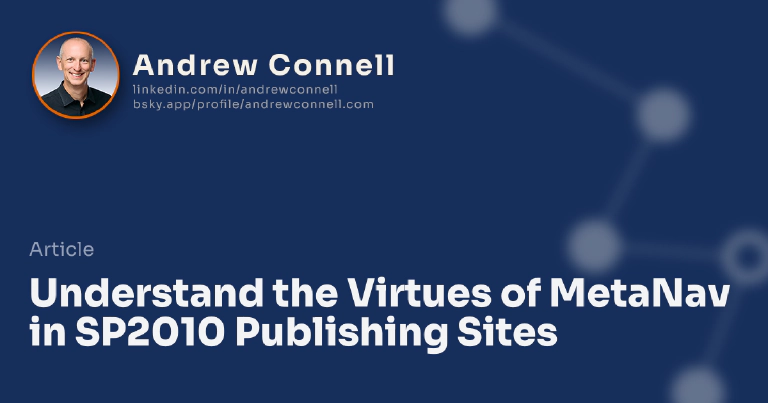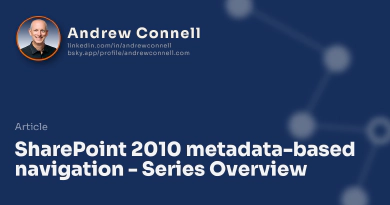This post is part of a series of posts… jump to the overview post that explains what it is all about and to get links on all the other posts here: SharePoint 2010 Metadata-Based Navigation in Publishing Sites.
What is MetaNav?
It’s the idea of using taxonomies provided by the Managed Metadata Service (MMS) in SharePoint Server. I’m using the term MetaNav to represent a Managed Metadata-Based Navigation.
Why Should You Consider MetaNav in SP2010 Publishing Sites?
Consider the challenges we have with SharePoint 2010 sites. Navigation is driven based on the topology of the site structure (sites, lists, pages). By its very nature, it can only see and surface content from within the current site collection. In addition, this implementation also only shows content where it lives; it doesn’t have the capability to show content in multiple places within the navigation. The workaround of creating a redirection page is just that: a bandaid.
A content site needs to be more flexible than this. It needs to be able to surface content from multiple sources, not just the current site collection. It needs to be able to surface content in multiple location so of the navigation, not just one place. All of this is possible if we move to a metadata-based navigation (MetaNav). Content can be tagged using terms from a taxonomy (or multiple taxonomies) as these are available across site collections. Then, the rollup pages that the navigation controls point to on your site use search to retrieve pages that match the criteria selected.
That’s the jist of the solution. In order to implement this in SP2010 there are a few things you need to build and some new practices you need to enforce/employ on your content owners. There are also a few gaps that are very hard to solve. I’ll explain both of these (the “things to build” and “gaps”) in future posts. But consider the advantages you get if you do this today: you’re making your site easier to migrate to SP2013 and you get a much more flexible navigation!
There are plenty of other reasons why this approach is appealing. Note that I’m not preaching that everyone should do this. Like everything else out there, take this as another approach to consider. Maybe it works for you, maybe it doesn’t. What do you think? Let’s start the conversation… comment away below!

Microsoft MVP, Full-Stack Developer & Chief Course Artisan - Voitanos LLC.
Andrew Connell is a full stack developer who focuses on Microsoft Azure & Microsoft 365. He’s a 21-year recipient of Microsoft’s MVP award and has helped thousands of developers through the various courses he’s authored & taught. Whether it’s an introduction to the entire ecosystem, or a deep dive into a specific software, his resources, tools, and support help web developers become experts in the Microsoft 365 ecosystem, so they can become irreplaceable in their organization.






